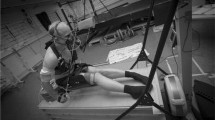Abstract
Eight subjects performed a single allout sprint on a cycle ergometer with strain gauges bonded to the cranks. The crank angle-torque curves of the left and right legs were recorded during ten revolutions using the software package supplied with the ergometer. Torque data were stored every 2° (180 angle-torque data per pedal revolution for each leg). The ergometer was used in the linear mode with the lowest available linear factor (F 1 = 0.01). In this mode, the braking torque (T B) was proportional to cycling velocity ν(T B =F 1ν) and mechanical power was equal toF 1ν2. The relationship between the torque averaged over one revolution and the average velocity of one pedal revolution was studied during the acceleration phase of short allout exercise on an electronic ergometer (eight subjects) and a friction-loaded ergometer (four subjects). The present study showed that it is possible to determine the maximal torque-velocity relationship and to calculate maximal anaerobic power during a single allout sprint using an electronic cycle ergometer provided that strain gauges are bonded to the cranks. The torque-velocity relationships calculated were linear as for a friction loaded ergometer. As expected, the values of torque and maximal power measured with the strain gauges were higher than the corresponding values computed from the data collected during an allout test on a friction loaded ergometer. The torque-angle data collected during a single allout cycling exercise would suggest that angular accelerations of the leg segments and gravitational forces play the main role at high velocity.
Similar content being viewed by others
References
Nadeau M, Cuerrier JP, Brassard A (1983) The bicycle ergometer for muscle power testing. Can J Appl Sci 8:41–46
Nakamura Y, Mutoh Y, Miyashita M (1985) Determination of the peak power output during maximal brief pedalling bouts. J Sports Sci 3:181–187
Patterson RP, Moreno MI (1990) Bicycle pedalling forces as a function of pedalling rate and power output. Med Sci Sports Exerc 22:512–516
Peres G, Vandewalle H, Monod H (1981) Aspect particulier de la relation charge-vitesse lors du pédalage sur cycloergomètre. J Physiol (Paris) 77:10A
Sargeant AJ, Hoinville E, Young A (1981) Maximal leg force and power output during short-term dynamic exercise. J Appl Physiol 51:1175–1182
Seek D, Vandewalle H, Decrops N, Monod H (1995) Maximal power and torque-velocity relationship on a cycle ergometer during the acceleration phase of a single all-out exercise. Eur J Appl Physiol 70:161–168
Suzuki S, Watanabe S, Homma S (1982) EMG activity and kinematics of human cycling movement at different constant velocities. Brain Res 240:245–258
Vandewalle H, Peres G, Monod H (1983) Relation force-vitesse lors d'exercices cycliques réalisés avec les membres supérieurs. Motric Hum 1:22–25
Vandewalle H, Peres G, Heller J, Monod H (1985) All-out anaerobic capacity test on cycle ergometers: a comparative study on men and women. Eur J Appl Physiol 54:222–229
Vandewalle H, Peres G, Heller J, Panel J, Monod H (1987) Force-velocity relationship and maximal power on a cycle ergometer. Correlation with the height of a vertical jump. Eur J Appl Physiol 56:650–656
Author information
Authors and Affiliations
Rights and permissions
About this article
Cite this article
Buttelli, O., Vandewalle, H. & Pérés, G. The relationship between maximal power and maximal torque-velocity using an electronic ergometer. Europ J Appl Physiol 73, 479–483 (1996). https://doi.org/10.1007/BF00334427
Accepted:
Issue Date:
DOI: https://doi.org/10.1007/BF00334427



